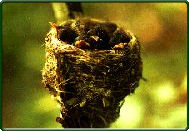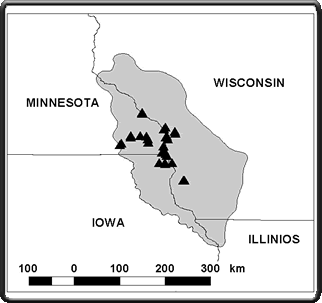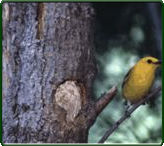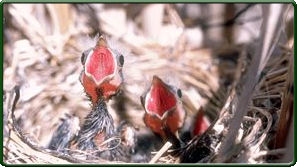Abundance, Diversity, and Productivity of Songbirds Nesting in Upland and Floodplain Forests of the Upper Mississippi River Basin
The Upper Mississippi River flows through the heart of the Driftless Area,a region that escaped glaciation during the most recent glacial advances.
|
|
|||||
Extending over portions of the states of Iowa, Minnesota, Wisconsin, and Illinois, the Driftless Area’s distinctive bluffs and valleys are remnants of the melting glaciers: dissected, upland plateaus with steep bedrock ridges descending to river drainages that ultimately flow to the Mississippi River. Climate, soils, topography, fire, and herbivore grazing interacted in the post-glacial period (10,000 yr B.P.) to create a complex landscape mosaic comprised of various types of prairie, oak savanna, and oak woodland over a large area of the Midwestern United States. Midwestern savannas represented a transition zone between the eastern deciduous forest and the tallgrass prairie. Periodic climatic fluctuations favored either prairie (dry, warm periods) or woodlands (cool, wet periods). In Wisconsin alone, oak savannas, barrens, and open woodlands occupied about 11 million acres; today less than 500 acres (<0.01%) survive. In the Midwest as a whole, oak savannas occupy only 0.02% of their estimated presettlement area. Nearly all of the former oak savannas in the Driftless Area have succeeded to closed canopy oak forests under fire suppression or were converted to cropland. These oak forests now support a diverse set of forest-nesting birds. There is considerable interest in managing these forests to support species of conservation concern. Land managers struggle to define restoration goals for these forests, given their historical condition and the practical limits of modern management. Problems include regenerating oak-dominated stands in the absence of fire and forest invasion by exotic shrub species. Most forest land is owned by small, private landowners; timber management practices vary greatly and are strongly influenced by economic forces (timber values). |
||||||
However, floodplain and riparian ecosystems are in trouble globally and regionally. The area of riparian forest in the North-central U.S. in 1940 was estimated at 6.9 million ha, dropping to 5 million ha in 1980 (-27.5%). Midwestern states have lost 20-90% of their presettlement riparian forests. Many rivers and streams have been altered by channelization, levees, and locks and dams; changes in hydrology are affecting riparian forest regeneration in the Upper Mississippi River. For example, tree species and age class diversity in floodplain forests of the Upper Mississippi River is lower than it was historically. Silvicultural efforts to regenerate and diversify these forests are hampered by a high water table and competition from invasive species. These long-term changes in floodplain forests have the potential to alter breeding habitat quality for some landbirds. We studied the bird communities of floodplain and upland forests of the Upper Mississippi River basin from 1991-2001. We described the assemblages of birds found in upland vs. floodplain forests, studied their nesting ecology, and learned how these birds are affected by forest succession, flooding, cowbird parasitism, and forest fragmentation. Project was completed in September 2001.
For more information, see these publications:
|
||||||
Page Last Modified: April 3, 2018






